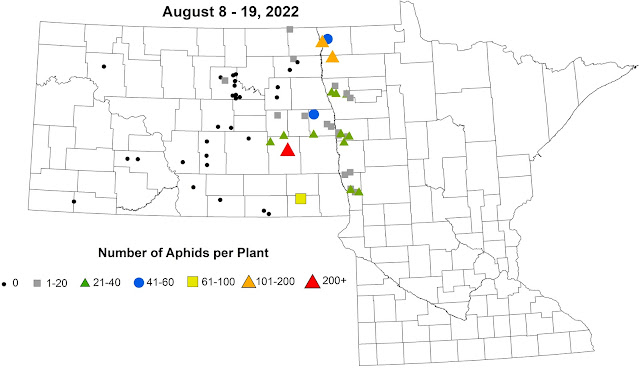Soybean growth & development
Between August 8 and 19, soybean growth stages from Wilkin County, Minnesota and north were either beginning seed (R5) or full seed (R6; Figure 1). Just last week during the August 10 Strategic Farming: Field Notes program, Extension soybean agronomist Dr. Seth Naeve explained that these are very different stages of soybean growth and development across the state. Soybeans at the R5 growth stage are still growing vegetatively while completing reproductive milestones, while soybeans at the R5.5 growth stage are no longer growing vegetatively and are thereafter devoted only to reproduction. It is recommended that soybeans continue to be scouted for soybean aphids through the beginning seed growth stage (R5) and until the pod cavities are filled with seeds (early R6). Soybean aphid’s ability to affect yield also decreases significantly at R6 to 6.5 as yield is already set at this point. Note that even if soybean aphids have reached treatment thresholds, some of the active ingredients labeled for soybean aphid may have restrictions based on the length of time between an application and harvest (pre-harvest interval) and so reading your pesticide label remains important all season long.
According to UMN Extension IPM specialist Bruce Potter, “As new vegetative growth ceases, many aphids leave the plants. The remaining aphids will be found lower in the canopy. Look for smaller aphids and nymphs lower in the canopy. During late R5 and early R6 these "dwarves" can reproduce rapidly and eventually produce more typical nymphs and adults. Late-planted fields and those with longer maturity varieties will be preferentially colonized by winged aphids now.”
 |
|
Figure 1. Soybean growth stages observed between August 8 and August 19, 2022. Map: NDSU IPM. |
Soybean aphid infestation incidence and severity
The northwest Minnesota fields that were scouted during this period had at least 1% of plants infested with soybean aphid, with the majority having between 51 and 79% of plants infested (Figure 2). This is VERY different from the soybean aphid populations observed in northwest Minnesota during last year’s drought, when only a handful of fields had up to 50% of plants infested. If you’ll recall, one element that should be present in order for a soybean field to meet the soybean aphid treatment threshold is that at least 80% of plants must be infested with soybean aphids.
 |
|
Figure 2. Soybean aphid incidence, or the percentage of plants infested with more than one soybean aphid. Map: NDSU IPM. |
Plants scouted in each field during this time frame each had more than one soybean aphid (Figure 3). The more southerly fields on the map had between 1 and 40 aphids per plant, while a handful of fields in Marshall and Kittson County had higher population densities, with two having an average of between 101 and 200 aphids per plant. Now that several calendar days have passed, there is a possibility that some of these fields will have recently reached another element of the treatment threshold - an average of 250 soybean aphids per plant. This threshold is well below when economic damage occurs to the plant -at around 670 aphids per plant- but is the trigger point to line up an application to occur over the coming days. Because of this, treatments below 250 aphids per plant are not likely to have return on investment. When scouting, bring a magnifying glass with you to the field if your bifocals aren’t up to date as you will want to look for soybean aphid nymphs toward the base of plants or many winged aphids. If your crop has just reached the treatment threshold and you encounter many winged aphids without a sense about whether they are coming or going, it may be prudent to wait a few days, scout again and see if the crop is still at the treatment threshold. This will satisfy the last of the elements needed to reach the treatment threshold: soybean aphid populations that are actively growing. As we move closer to September, it becomes less and less likely that an application will be beneficial as aphids begin to move back to buckthorn.
 |
|
Figure 3. Soybean aphid severity, or the number of soybean aphids per plant. Map: NDSU IPM. |
Two-spotted spider mites
Unlike last year, when people throughout the scouted region in northwest Minnesota had a difficult treatment decision to make (fields at the treatment threshold had people questioning whether there was yield potential to protect)- two-spotted spider mite populations were not found on either the edges (Figure 4) or interiors (Figure 5) of soybean fields scouted this year.
 |
| Figure 4. Presence (red triangle) of two-spotted spider mites on the edge of soybean fields. Map: NDSU IPM |
 |
| Figure 5. Presence (red triangle) of two-spotted spider mites inside soybean fields. Map: NDSU IPM |
Comments
Post a Comment